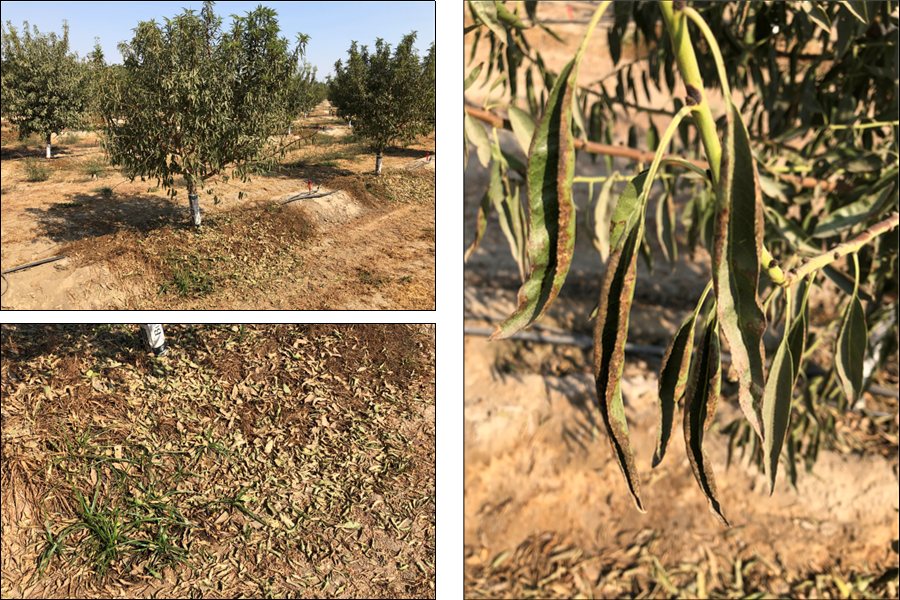Field Notes: Peach Silver Mite in Almonds
By Cameron Zuber, Graduate Student, UC Merced
Also posted on The Almond Doctor (Posted October 26, 2020)
In the middle of October 2020, a second leaf almond orchard in Parlier, CA presented with a lot of leaves on the ground in the ‘Sonora’ pollinator rows. It was a bit early for the trees to enter dormancy and deficient irrigation was not performed as the orchard was too young to be harvested this year. Upon closer inspection the leaves on the trees seemed to indicate a pest or disease issue.
Photos of ‘Sonora’ almond (top left) with heavy amount of leaf drop (bottom left) and leaves with pest or disease damage (right).
Early leaf drop in almonds is a concern as it may impact the flower buds developing on the tree which could impact next year’s bloom vigor and crop yields. The browning on the leaf could indicate salt burn or leaf scorch (http://thealmonddoctor.com/2014/07/25/salt-burn-vs-leaf-scorch/) and some leaves had rust present (http://thealmonddoctor.com/2010/04/05/almond-leaf-rust-treat-now-to-prevent-late-season-defoliation/). However, the splotchiness of the browning did not seem typical of salt burn or leaf scorch and the rust was not prevalent enough to cause this degree of leaf drop.
Photos of almond leaves from orchard with splotchy browning and rust.
The symptoms seemed more severe on the ‘Sonora’ trees, but the ‘Nonpareil’ trees were showing similar symptoms though less severe. Another odd symptom was a silvery color to the leaves which became more apparent when looking through a hand lens and compared to healthy leaves from a neighboring block.
Photos of almond leaves with silvery color in orchard (top) and heathy color from a neighboring orchard (bottom).
The combination of splotchy browning and silvery color started to indicate a potential culprit for the early leaf drop. Browning is a symptom of rust and a silvery color indicates thrips or leafhopper damage but having both indicated something else. Looking through a strong hand lens showed the presence of peach silver mite (Aculus cornutus). Peach silver mite can be distinguished by their teardrop body shape which is different from other mites typically found in almonds, such as webspinning spider mites. However, a strong hand lens at 15x or higher is needed to even see peach silver mite which makes early season identification difficult. Peach silver mite feeding causes a silver color on the leaf and during higher temperatures feeding spots may cause browning.
Photo of peach silver mite from the orchard back lit under a strong lens (left). Back light is causing the peach silver mite to look transparent and grey, but the teardrop body shape is still visible. Photos from UC IPM shows peach silver mite (right top) and twospotted spider mite (right bottom, Tetranychus urticae) under better lighting and similar magnification.
UC IPM (https://www2.ipm.ucanr.edu/agriculture/almond/Peach-Silver-Mite/) says the peach silver mite is normally considered a beneficial because it serves as a food source for mite predators that would feed on more harmful types of mite. However, peach silver mites may cause problems in younger orchards if populations reach high enough level to cause early leaf drop. For this orchard, the amount of leaf drop was concerning especially as the ‘Nonpareil’ trees were showing similar symptoms to the ‘Sonora’ trees. Therefore, a treatment is being considered. UC IPM recommends a narrow range oil, wettable sulfur, or abamectin to treat peach silver mite. A low-level zinc sulfate spray was already planned for this orchard to help with zinc deficiency issues (application of 5 lbs per acre). While not a recommended product for peach silver mite, the sulfur in zinc sulfate may help, so continued monitoring will be conducted after the spray to see if the peach silver mite population will drop to an acceptable level.
Special thanks to Brent Holtz (Farm Advisor with UC Cooperative Extension in San Joaquin County) for assistance with determining the issue with this orchard.
The Almond Doctor Field Note is a series of posts that will cover observations made from the field by staff research assistants of the University of California Cooperative Extension office of Merced County. While Field Note posts may reference completed or on-going research, its intent is share notable observations from the field, not to summarize research findings or describe current recommended farming practices.




